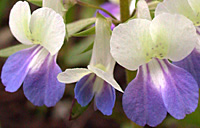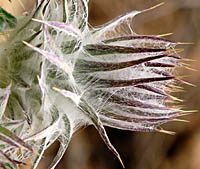Siskiyou Chapter: Sites to Visit
Some places to visit in the Siskiyou Chapter area:
Lower Table Rock

Best time to go: March – June
Directions: From I-5 northwest of Medford, take Central Point Exit 33. Go east on E. Pine St., which turns into Biddle Rd., about one mile. Turn left on Table Rock Road. Drive north 7.6 miles. Turn left on Wheeler Rd. Go about a mile to the signed parking area for Lower Table Rock, on the left. There are restrooms here, but no facilities beyond this. Water is not available. The well-maintained trail gains 800′ in 1.8 miles to the flat, expansive mesa-like top. This is a joint Nature Conservancy/BLM managed area. Dogs allowed only if leashed.

What to see: With masses of camas lilies along the lower trail, and carpets of goldfields and blue eyed Mary on top, Lower Table Rock is a delight to the eye from early spring into summer. The changing wildflower display includes the rare dwarf wooly meadow foam, which grows only on top of Lower (and Upper) Table Rock, pretty purple grass widows, red bells, yellow bells, and sea blush. From the top are inspiring vistas into the Rogue Valley and Sams Valley, south to the Siskiyou crest, and east to Mt. McLaughlin. Allow a half-day minimum for a visit; try to go two or three times over the season to see all the changes.
TJ Howell Botanical Drive
Best time to go: May – July
Directions: From Grants Pass, take U.S. Highway 199 south. Go 3.5 miles past Selma to the junction with Eight Dollar Mountain Road. Turn right. Go about one mile to where there is a gate (normally open) and a rough spot in the road where a cattle guard used to be. The drive begins here. (There is another gate here, almost always closed and locked, blocking vehicle access to a narrow paved road uphill to the right. A short walk up that road gives access to a boardwalk across the upper end of Howell’s Fen, and is worth a visit.) The TJ Howell Botanical Drive follows Forest Service Road 4201 fourteen miles, gains 3000′, and reaches the boundary of the Kalmiopsis Wilderness and trailheads to Whetstone Butte and Babyfoot Lake. The upper end of the road may be closed by snow into June.

What to see:This driving tour, with frequent stops to see plants and the views, goes through and by a variety of plant habitats, including pine savannah, serpentine fens, river corridor, and douglas fir forest. Some of the area was burned in the 2002 Biscuit Fire. Plants that might be seen along the way include phlox, iris, California lady’s-slipper orchid, a variety of lomatiums, penstemons, heartleaf milkweed, cobwebby thistle, and a plethora of lilies: rush lilies, the rare Howell’s mariposa lily, Volmer’s lily, Bolander’s lily, Washington lily, and lemon fawn lilies.
A detailed guide to the drive can be downloaded for printing here: TJ Howell Drive.
Mt. Ashland

Best time to go: mid-June – mid-August
Directions: From Ashland, go south on I-5 about 10 miles. Leave I-5 at Exit 6. Continue up the frontage road for a mile, then turn right on Mt. Ashland Ski Road. Five miles on, watch for the Pacific Crest Trail where it intersects the road. This is one spot to stop and hike along the trail through the forest, in the same direction you’ve been driving. Driving another 3 miles, you’ll pass the ski area lodge and parking. Keep going through the gate, where the pavement ends. Soon the road goes through a Forest Service Campground, with rest rooms. From here on to Grouse Glade, about two miles further, is an incredibly rich series of hillside meadows above and below the roadway. At Grouse Glade is a cross-country ski shelter just down the hill to the left. The PCT crosses the spur road to the shelter. A half mile before Grouse Glade, a road goes up the hill to the right, giving access to the Rabbit Ears area, and the top of Mt. Ashland, both good spots for botanizing. The road at the gate near the ski area may be closed by snow well into June.
What to see: Glacier lily, several different violets, checker lily, several penstemons, orchids, larkspur, monkshood, checkerbloom, Wiggin’s lily, scarlet gilia, and pussytoes are just some of the hundreds of species that can be found on Mt. Ashland.
